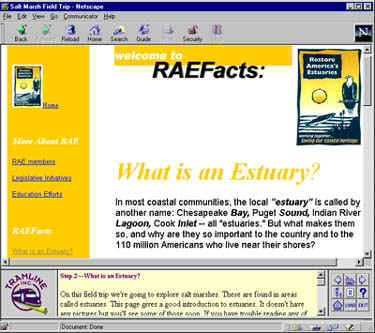

| |
*Teacher's Resource Field Trip |
|
Trailhead ---- Teacher's Resources ---- Start Field Trip |
|
|
|
|
|
Developing Virtual Field Trips As teachers, we know that field trips motivate and educate our kids. We also know they are time-consuming, difficult to organize, and often affected by the weather. In many cases, the places we would most like to visit aren't nearby or aren't open at the time we are covering them in the curriculum. In these cases, the next best thing to a real field trip is a virtual field trip. In fact, virtual field trips are often better because they take you places you couldn't otherwise go, for example, inside a volcano, under the ocean, or straddling a fault line.
What is a Virtual Field Trip?What is a virtual field trip? It's a guided and narrated tour of Web sites that have been selected by educators like yourself and arranged in a "thread" that students can follow from site to site with just the click of a single button. Using Tramline technology, teachers like us can create easy-to-follow tours so students no longer have to work from lists of Web sites. This is a real advantage because lists of links are not easy to work from at any level, but they are especially difficult for elementary school children.
Virtual field trips are the best way to assemble, or thread together, the most important sites that tell a story or follow a theme. In addition to an easy-to-follow thread, the narration window contains text explaining the site, putting it in context for the grade level and theme you are studying, and providing additional links to take students to key pages on the site. Once published on the Web, other teachers no longer have to start from scratch and find the time to assemble the sites they want their students to visit. The biggest help we can give teachers is to have professionals do this work for them and provide them with the needed tools so they can spend their time on other aspects of their work. Virtual and Real Field TripsVirtual and real trips are different from one another, but they also have many features in common. Let's take a look at these differences and similarities. Similarities
The following tour will allow you to explore the usefulness of this approach.
|
|
VFT Home | About | Field Trip List | Lounge | Standards
the
software | the field trips | the
book | the training
Home | About Tramline
| Support | Store
| Contact
Send mail to ![]() with
questions or comments about this Web site.
with
questions or comments about this Web site.
Copyright © 1996-2007 Tramline. All rights reserved. Legal
Agreement.



